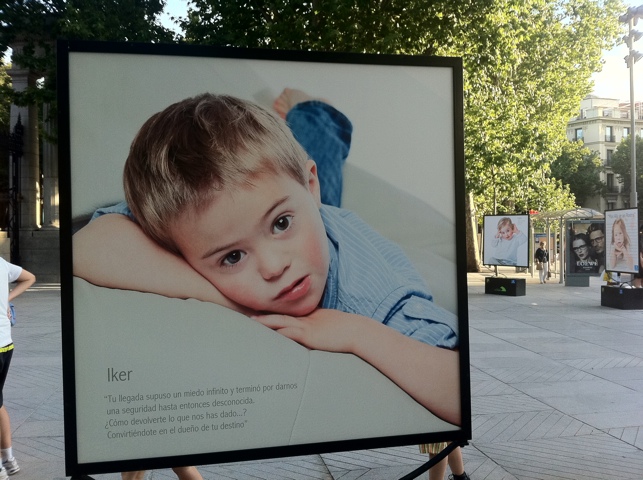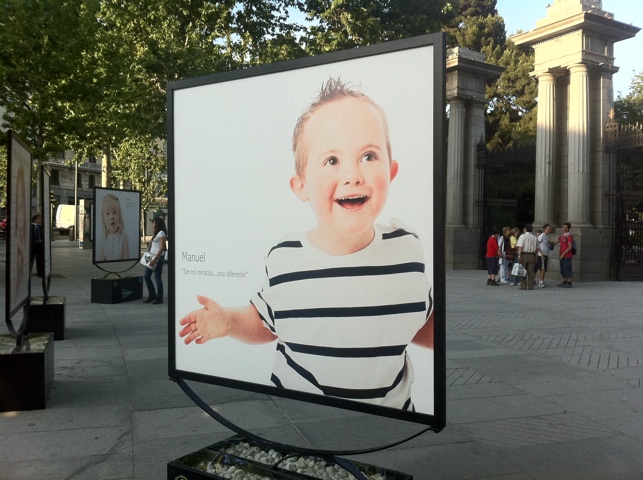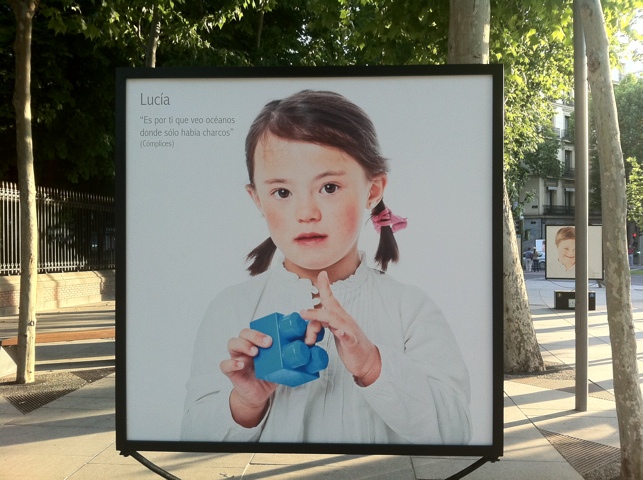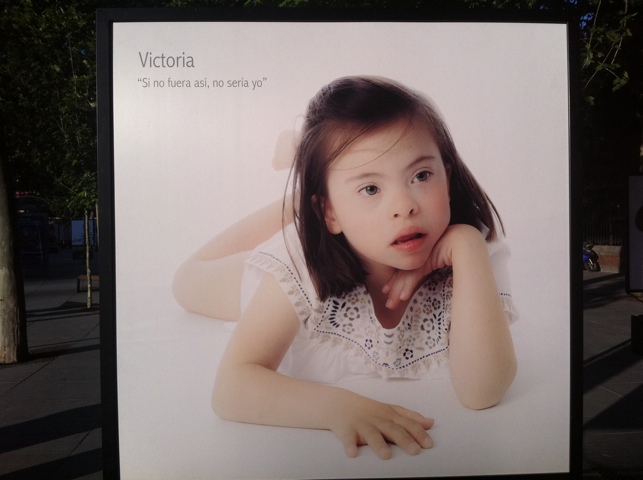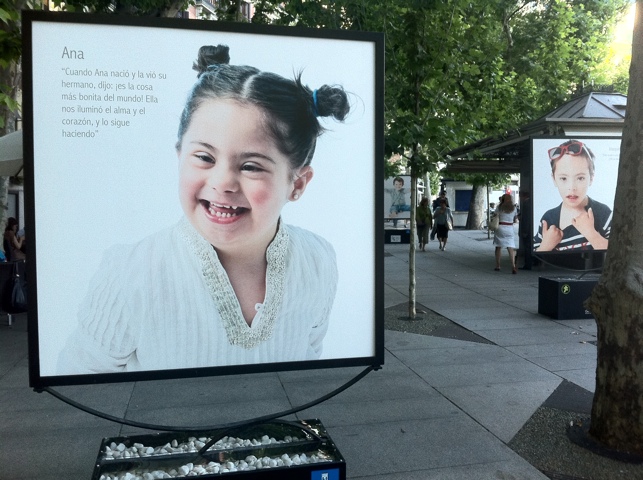William decided it would be fun yesterday to take some silly pictures with Ama. He was having a fun day and even decided to try and roast marshmellows on the stove top. Love summer!
Happy home, two girls, two boys, one with an extra special chromosome. Loving life. And being gentle.
▼
Thursday, June 30, 2011
Wednesday, June 29, 2011
Getting out of bed is hard
The boys do not like getting out of bed in the morning. Extended school year started for Davey on Monday so his summer sleep in time is short. The bus arrives at our house at 6:40 in the morning. It brings him home at 1:30. He loves Extended School Year (he loves school period, lol). BUT, getting out of bed in the mornings is always an adventure. This morning he woke up with a smile.
Monday, June 27, 2011
"Glee"fully loving the message. Spread the word to end the word.
June 27, 2011 in Features
‘Glee’ gives lift to campaign to educate public on R-word
When it comes to the word, try rejection
Kim Hone-Mcmahan Akron Beacon Journal
It’s a slur just like any other. It hurts, and yet many, including some sports heroes and musical artists, think it’s somehow OK to include it in their conversations.
The word is “retard” (or “retarded”) – otherwise known as the R-word. And it’s the subject of a wide-reaching campaign to educate folks about how its use can cause great pain.
“Not Acceptable,” a public service announcement created by Spread the Word to End the Word, aired during the recent finale of Fox’s hit series “Glee.”
The brief spot began with an African-American man saying it is not acceptable to call him the N-word, followed by others repeating similar sentiments about racial, sexual and religious slurs.
At the end, “Glee” actress Lauren Potter, who has Down syndrome, said: “It’s not acceptable to call me a retard or call yourself or your friends retarded.”
More than 200,000 people have made pledges at www.r-word.org in support of eliminating the derogatory use of the word from their everyday speech.
Lori Hurt, a special-education teacher in Akron, Ohio’s Leggett Elementary School, is passionate about the subject. She joined the campaign a few months ago.
“The only way that people will stop saying it is if you make people aware that it’s hurtful. And how it is damaging to people who have disabilities and their families and friends,” says Hurt, who has a sister with Down syndrome.
“I think people say the word but don’t equate it with a group. But it is associated with a group. If you say the N-word, it is obviously associated with a group in your mind. But not necessarily the R-word. It needs to stop.”
Hurt explains that “retarded” and “retardation” are definable terms, medically. They have been used in publications and in the names of organizations.
“But the way it has transcended into a slur is totally degrading,” she says.
“The thing about people with disabilities is that it can happen to any family, of any age, in any location in the world, and at any time in their lives. It just surprises me that people aren’t more understanding.”
Claudia Anger, of Cuyahoga Falls, Ohio, has cerebral palsy. Though she is unable to speak, she motioned with her hands to show tears falling from her eyes when explaining how it feels to be mocked or called names.
“People call me the R-word all of the time,” she typed in a message to a reporter. “I’m not R-word … it makes me feel small and hurts my feelings.
“I have the same feelings (others) have and you have no right to call me that word – and no right to call my best … friends the R-word. It’s not right. I wouldn’t call you words.”
While people who are discriminated against because of race, religion or sexual orientation can defend themselves, people with disabilities are often unable to do that, Hurt says.
“All people,” she says, “regardless of their abilities, deserve respect.”
Sunday, June 26, 2011
Down Syndrome Health Check List
Does your health care provider know that our kids need a few extra screenings at each visit? Do they use the DS growth chart? What are the recommendations? Although this is from 1999, it still provides a great starting place for use by providers. Do the research. Get the best care for our kids.
Instructions: Perform indicated exam/screening and record date in blank spaces. The grey or shaded boxes mean no action is to be taken for those ages.
1Begin Dental Exams at 2 years of age, and continue every 6 months thereafter.
2IgA antiendomysium antibodies and total IgA.
3Cervical spine x-rays: flexion, neutral and extension, between 3-5 years of age. Repeat as needed for Special Olympics participation. Neurological examination at each visit.
© Down Syndrome Quarterly, 1999. This record sheet may be printed out for individual use but may not be reproduced on any website without prior permission.
Instructions: Perform indicated exam/screening and record date in blank spaces. The shaded boxes mean no action is to be taken for those ages.
1Begin Dental Exams at 2 years of age, and continue every 6 month thereafter.
2Cervical spine x-rays: flexion, neutral and extension, between 3-5 years of age. Repeat as needed for Special Olympics participation. Neurological examination at each visit.
3If sexually active.
© Down Syndrome Quarterly, 1999. This record sheet may be printed out for individual use but may not be reproduced on any website without prior permission.
Be gentle.
Reprinted from Down Syndrome Quarterly , Volume 4, Number 3, September 1999
Down Syndrome Health Care Guidelines (1999 Revision) Record Sheet
Name: ________________________________ Birthday: ______________________________
Down Syndrome Health Care Guidelines (1999 Revision) Record Sheet
Sheet #1: Birth to Age 12 Years
Name: ________________________________ Birthday: ______________________________
| Age, in years | ||||||||||||||||
| Medical Issues | At Birth or at Diagnosis | 6-mo | 1 | 1-1/2 | 2 | 2-1/2 | 3 | 4 | 5 | 6 | 7 | 8 | 9 | 10 | 11 | 12 |
| Karotype & Genetic Counseling | _____ | |||||||||||||||
| Usual Preventative Care | _____ | ___ | ___ | ___ | ___ | ___ | ___ | ___ | ___ | ___ | ___ | ___ | ___ | ___ | ___ | ___ |
| Cardiology | Echo | |||||||||||||||
| Audiologic Evaluation | ABR or OAE | ___ | ___ | ___ | ___ | ___ | ___ | ___ | ___ | ___ | ___ | ___ | ___ | ___ | ___ | ___ |
| Ophthalmologic Evaluation | Red reflex | _____ | ___ | ___ | ___ | ___ | ___ | ___ | ___ | ___ | ___ | ___ | ___ | ___ | ||
| Thyroid (TSH & T4) | State screening | _____ | ___ | ___ | ___ | ___ | ___ | ___ | ___ | ___ | ___ | ___ | ___ | ___ | ||
| Nutrition | _____ | ___ | ___ | ___ | ___ | ___ | ___ | ___ | ___ | ___ | ___ | ___ | ___ | ___ | ___ | ___ |
| Dental Exam1 | ___ | ___ | ___ | ___ | ___ | ___ | ___ | ___ | ___ | ___ | ___ | ___ | ||||
| Celiac Screening2 | ___ | |||||||||||||||
| Parent Support | _____ | ___ | ___ | ___ | ___ | ___ | ___ | ___ | ___ | ___ | ___ | ___ | ___ | ___ | ___ | ___ |
| Developmental & Educational Services | Early Intervention | ___ | ___ | ___ | ___ | ___ | ___ | ___ | ___ | ___ | ___ | ___ | ___ | ___ | ___ | ___ |
| Neck X-rays & Neurological Exam3 | X- ray | ___ | ___ | ___ | ___ | ___ | ___ | ___ | ___ | ___ | ||||||
| Pneumococcal Conjugate Vaccine Series | _______ | |||||||||||||||
Instructions: Perform indicated exam/screening and record date in blank spaces. The grey or shaded boxes mean no action is to be taken for those ages.
1Begin Dental Exams at 2 years of age, and continue every 6 months thereafter.
2IgA antiendomysium antibodies and total IgA.
3Cervical spine x-rays: flexion, neutral and extension, between 3-5 years of age. Repeat as needed for Special Olympics participation. Neurological examination at each visit.
© Down Syndrome Quarterly, 1999. This record sheet may be printed out for individual use but may not be reproduced on any website without prior permission.
Reprinted from Down Syndrome Quarterly, Volume 4, Number 3, September, 1999
Down Syndrome Health Care Guidelines (1999 Revision) Record Sheet
Sheet #2: 13 Years to Adulthood
Name: ________________________________ Birthday: ____________________________
Age, in years | ||||||||
| Medical Issues | 13 | 14 | 15 | 16 | 17 | 18 | 19 | 20-29 |
| Usual Preventative Care | ___ | ___ | ___ | ___ | ___ | ___ | ___ | ___ |
| Audiologic Evaluation | ___ | ___ | ___ | ___ | ___ | ___ | ___ | ___ |
| Ophthalmologic Evaluation | ___ | ___ | ___ | ___ | ___ | ___ | ___ | ___ |
| Thyroid (TSH & T4) | ___ | ___ | ___ | ___ | ___ | ___ | ___ | ___ |
| Nutrition | ___ | ___ | ___ | ___ | ___ | ___ | ___ | ___ |
| Dental Exam1 | ___ | ___ | ___ | ___ | ___ | ___ | ___ | ___ |
| Parent Support | ___ | ___ | ___ | ___ | ___ | ___ | ___ | ___ |
| Developmental & Educational Services | ___ | ___ | ___ | ___ | ___ | ___ | ___ | ___ |
| Neck X-rays & Neurological Exam2 | ___ | ___ | ___ | ___ | ___ | ___ | ___ | ___ |
| Pelvic exam3 | ___ | ___ | ___ | ___ | ___ | |||
| Assess Contraceptive Need3 | ___ | ___ | ___ | ___ | ___ | |||
Instructions: Perform indicated exam/screening and record date in blank spaces. The shaded boxes mean no action is to be taken for those ages.
1Begin Dental Exams at 2 years of age, and continue every 6 month thereafter.
2Cervical spine x-rays: flexion, neutral and extension, between 3-5 years of age. Repeat as needed for Special Olympics participation. Neurological examination at each visit.
3If sexually active.
© Down Syndrome Quarterly, 1999. This record sheet may be printed out for individual use but may not be reproduced on any website without prior permission.
Be gentle.
Saturday, June 25, 2011
Twins!
I love this picture of my boys. Yes, they are twins. Baby A and Baby B. I will never forget the day when we discovered the day we found out we were having TWO BOYS! I love this picture taken a few years ago.
Be gentle.
Be gentle.
Friday, June 24, 2011
Countdown to the Special Olympics World Games
One day until the Opening of the Special Olympics World Games 2011 in Athens Greece |
The Emblem of the Special Olympics World Summer Games ATHENS 2011 is a radiant sun, the source of life that underlines the excellence and power of the athlete that takes part in the Games. Excellence is depicted in the olive branch and power in the spiral form in the center of the sun. The colors reflect the Greek landscape and project emotions like passion for life in the warm red, optimism in the orange, determination in the blue, freedom in the light blue and hope in the green.
Thursday, June 23, 2011
Myth or Truth?
 |
| Davey listening to his coach at the basketball tournament |
Taken from the NDSS web site..... Myth: Down syndrome is a rare genetic disorder. Truth: Down syndrome is the most commonly occurring genetic condition. One in every 691 live births is a child with Down syndrome, representing approximately 6,000 births per year in the Myth: People with Down syndrome have a short life span. Truth: Life expectancy for individuals with Down syndrome has increased dramatically in recent years, with the average life expectancy approaching that of peers without Down syndrome. Myth: Most children with Down syndrome are born to older parents. Truth: Most children with Down syndrome are born to women younger than 35 years old simply because younger women have more children. However, the incidence of births of children with Down syndrome increases with the age of the mother. Myth: People with Down syndrome are severely “retarded.” Truth: Most people with Down syndrome have IQs that fall in the mild to moderate range of intellectual disability (formerly known as “retardation”). Children with Down syndrome fully participate in public and private educational programs. Educators and researchers are still discovering the full educational potential of people with Down syndrome. Myth: Most people with Down syndrome are institutionalized. Truth: Today people with Down syndrome live at home with their families and are active participants in the educational, vocational, social, and recreational activities of the community. They are integrated into the regular education system and take part in sports, camping, music, art programs and all the other activities of their communities. People with Down syndrome are valued members of their families and their communities, contributing to society in a variety of ways. Myth: Parents will not find community support in bringing up their child with Down syndrome. Truth: In almost every community of the Myth: Children with Down syndrome must be placed in segregated special education programs. Truth: Children with Down syndrome have been included in regular academic classrooms in schools across the country. In some instances they are integrated into specific courses, while in other situations students are fully included in the regular classroom for all subjects. The current trend in education is for full inclusion in the social and educational life of the community. Increasingly, individuals with Down syndrome graduate from high school with regular diplomas, participate in post-secondary academic and college experiences and, in some cases, receive college degrees. Myth: Adults with Down syndrome are unemployable. Truth: Businesses are seeking young adults with Down syndrome for a variety of positions. They are being employed in small- and medium-sized offices: by banks, corporations, nursing homes, hotels and restaurants. They work in the music and entertainment industry, in clerical positions, childcare, the sports field and in the computer industry. People with Down syndrome bring to their jobs enthusiasm, reliability and dedication. Myth: People with Down syndrome are always happy. Truth: People with Down syndrome have feelings just like everyone else in the population. They experience the full range of emotions. They respond to positive expressions of friendship and they are hurt and upset by inconsiderate behavior. Myth: Adults with Down syndrome are unable to form close interpersonal relationships leading to marriage. Truth: People with Down syndrome date, socialize, form ongoing relationships and marry. Myth: Down syndrome can never be cured. Truth: Research on Down syndrome is making great strides in identifying the genes on chromosome 21 that cause the characteristics of Down syndrome. Scientists now feel strongly that it will be possible to improve, correct or prevent many of the problems associated with Down syndrome in the future. |
Wednesday, June 22, 2011
Special Olympics Oath, words we should all live by
"Let me win. But if I cannot win, let be brave in the attempt."
Tuesday, June 21, 2011
Celebrating Summer
I met David, Ama (our wonderful new Au Pair) and the boys at the Santa Cruz Beach Boardwalk after work today. We all had a great time. David, Ama and the boys got lots of sun. We all had a great time.
Santa Cruz beach
Davey and Ama
Davey
William
William and Dad
Davey
Ama and the boys
Enjoying the sun
My pirates!
Riding a motorcycle
Intense game of air hockey
Davey loves air hockey
William
Davey and Ama
Ama and the boys
Monday, June 20, 2011
Down Syndrome Kids. Wow!
Down Syndrome Kids
A good publicity campaign for kids with Down’s Syndrome, in Majadahonda (Madrid). 130 artistic photographs, with deeply moving messages. Some of them, here:
“I have an extra chromosome. What is special about you?”
“When I arrived home, my mom and dad didn’t know what to do with me. Now they wouldn’t know how to do without me!”
“The biggest treasure ever found.”
“When I grow up, I’ll be happy. What will you be?”
“Making other people better is not for everyone. Just for the best.”
“Just one of the family.”
“The biggest treasure ever found.”
“When I grow up, I’ll be happy. What will you be?”
“Making other people better is not for everyone. Just for the best.”
“Just one of the family.”
Congratulations to the Down Syndrome Foundation Madrid, and to Pablo Herreros, for bringing these photos to the notice of our webmaster:

























